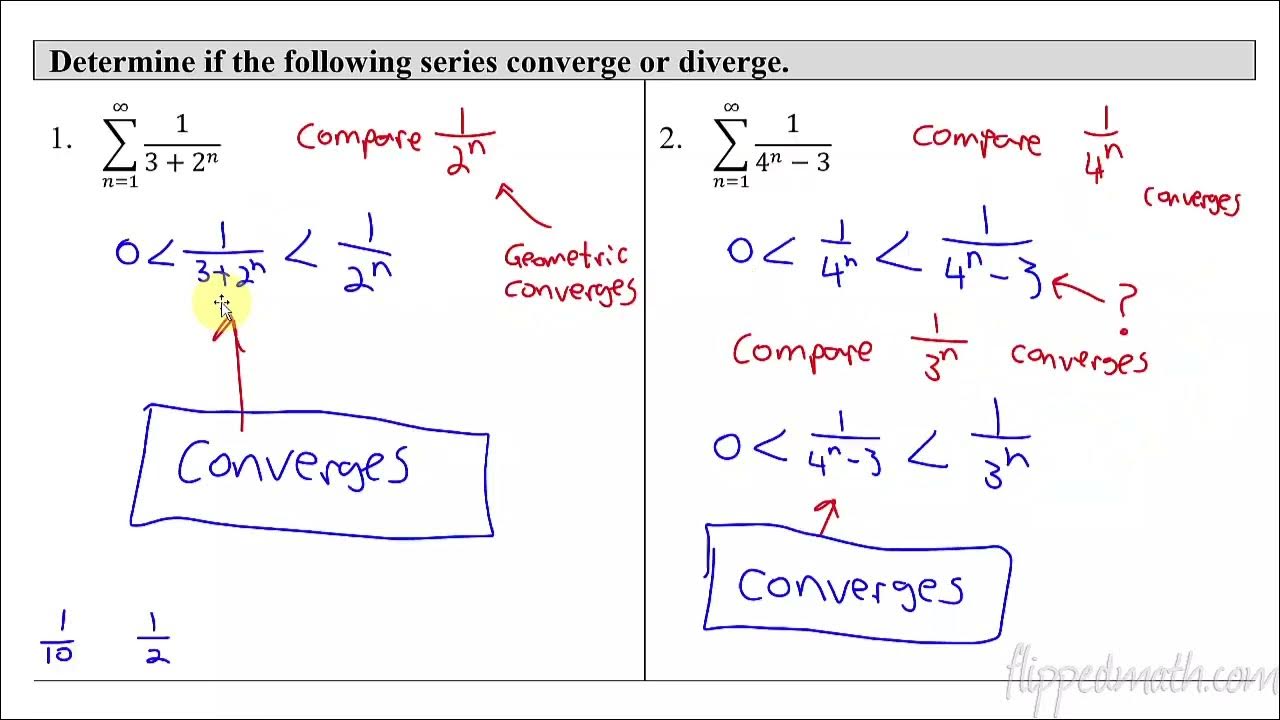Avon High School - AP Calculus BC - Topic 10.6 - Examples 2 and 3
TLDRIn this video, the concept of the Limit Comparison Test for determining the convergence or divergence of series is introduced. The test is particularly useful when a direct term-by-term comparison is difficult. The video provides a step-by-step explanation of how to apply the test, including choosing an appropriate series for comparison and understanding the behavior of the series involved. Examples are given to illustrate the process, and a comparison with the Direct Comparison Test is briefly discussed. Additionally, a lesser-known Polynomial Test is mentioned as a special case of the comparison test, offering a potential time-saving strategy for certain problems.
Takeaways
- 📚 The lesson focuses on the Limit Comparison Test for determining the convergence or divergence of series, which is an alternative to the Direct Comparison Test.
- 🔄 The Limit Comparison Test involves dividing the nth term of the given series by another series (preferably with positive terms) and evaluating the limit as n approaches infinity.
- 🌟 If the resulting limit is a finite positive number, the series being compared will behave similarly; if the limit is infinite or negative, the test does not provide a conclusion.
- 🚫 The Direct Comparison Test may not be suitable when it's difficult to establish a term-by-term comparison due to complex expressions in the series.
- 🔢 The test requires that both series have positive terms to be valid; if the terms are not inherently positive, transformations may be necessary.
- 📈 The behavior of the series is determined by comparing the growth rates of the series' terms, which can be simplified by focusing on the most significant factors.
- 🌐 Examples provided in the script illustrate how to apply the Limit Comparison Test to various series, including harmonic series and series with polynomial terms.
- 💡 The Polynomial Test is introduced as a special case of the comparison test, applicable only to polynomial series, and can be a quick method for certain problems.
- 📊 When using the Polynomial Test, if the degree of the numerator polynomial is less than the degree of the denominator polynomial minus one, the series converges; otherwise, it diverges.
- 🎓 The lesson emphasizes the importance of understanding the underlying behavior of series and the flexibility in choosing appropriate series for comparison.
- 🔜 The next topic will cover the Alternating Series, expanding the knowledge of series convergence and divergence tests.
Q & A
What is the main topic of the video?
-The main topic of the video is the Limit Comparison Test, a method used to determine the convergence or divergence of series.
When is the Limit Comparison Test useful?
-The Limit Comparison Test is useful when it's difficult to establish a term-by-term comparison using the Direct Comparison Test, especially when dealing with complicated expressions in the nth term.
How does the Limit Comparison Test work?
-The Limit Comparison Test works by taking the limit of the ratio of the nth term of the given series to the nth term of a comparison series, which should both contain positive terms. If the limit is a finite positive number, the two series will behave similarly.
What should be the nature of the terms in the series when using the Limit Comparison Test?
-The terms in the series when using the Limit Comparison Test should be positive to ensure a valid comparison.
What is the significance of the limit being finite and positive in the Limit Comparison Test?
-If the limit is finite and positive, it indicates that the given series will behave similarly to the comparison series, meaning if one diverges or converges, the other will do the same.
How does the video demonstrate the application of the Limit Comparison Test?
-The video demonstrates the application of the Limit Comparison Test through examples, showing how to compare series by taking limits, simplifying expressions, and interpreting the results to determine convergence or divergence.
What is the Polynomial Test mentioned in the video?
-The Polynomial Test is a special case of the Comparison Test that applies to polynomials of degree j and k. It states that if the exponent of the numerator is smaller than the denominator minus one, the series converges; if it's equal or larger, the series diverges.
Why is the Polynomial Test not commonly used on the AP Calculus exam?
-The Polynomial Test is not commonly used on the AP Calculus exam because it is not one of the big nine comparison tests and is not specifically addressed on the exam.
What advice does the instructor give for using the Limit Comparison Test?
-The instructor advises students to use the Limit Comparison Test as they work through problems, especially when dealing with polynomials, as it can save time on multiple-choice questions where meticulous work is not required.
How does the video conclude?
-The video concludes by summarizing the key points of the Limit Comparison Test and mentioning that the next topic will be the Alternating Series.
What is the instructor's approach to handling complex terms in the nth expression?
-The instructor suggests simplifying the expression by focusing on the most significant terms, such as the n value, and ignoring less significant terms to make the comparison easier.
Outlines
📚 Introduction to Limit Comparison Test
This paragraph introduces the concept of the limit comparison test, a method for determining the convergence or divergence of series. It explains that this test is particularly useful when a direct term-by-term comparison is difficult due to complicated expressions in the series. The limit comparison test involves dividing the nth term of the given series by another series with positive terms and evaluating the limit as n approaches infinity. If the limit is a finite positive number, the series behave similarly.
🔍 Applying the Limit Comparison Test
The paragraph delves into the application of the limit comparison test using a specific example. It discusses the choice of series for comparison and emphasizes the flexibility in selecting the comparison series. The example involves a general harmonic series with a potential coefficient variation, and the paragraph guides through the steps of setting up and solving the limit comparison test to determine the series' behavior.
📈 Interpreting Results and Choosing Comparison Series
This section focuses on interpreting the results of the limit comparison test and provides guidance on choosing the appropriate comparison series. It explains how to simplify the comparison by focusing on the significant terms of the series and provides examples of series that would converge or diverge based on the test. The paragraph also introduces the concept of flexibility in the choice of comparison series and encourages understanding the behavior of the series being compared.
🧠 Working Through Complex Examples
The paragraph presents more complex examples and illustrates the process of working through them using the limit comparison test. It emphasizes the importance of simplifying the series and choosing the right comparison series to draw accurate conclusions. The examples include series with radicals and polynomials, and the paragraph explains how to manipulate these expressions to make them comparable, ultimately determining their convergence or divergence.
🌟 Introducing the Polynomial Test
In the final paragraph, a lesser-known test called the polynomial test is introduced as a special case of the comparison test. This test is applicable to polynomials and helps determine the convergence of a series by comparing the exponents of the numerator and denominator polynomials. The paragraph explains the conditions under which the series converges or diverges based on the polynomial test and suggests using this test as a time-saving strategy for certain problems, especially those involving polynomials.
Mindmap
Keywords
💡Limit Comparison Test
💡Direct Comparison Test
💡Convergence
💡Divergence
💡nth Term
💡Positive Terms
💡Harmonic Series
💡Geometric Series
💡P-Series
💡Behavior of Series
💡Polynomial Test
Highlights
Introduction to the limit comparison test for series, a method for determining the convergence or divergence of a series by comparison.
The limit comparison test is particularly useful when a term-by-term comparison is difficult or not feasible due to the complexity of the series' terms.
To apply the limit comparison test, the series must contain only positive terms, which is a prerequisite for the test to be valid.
The process of the limit comparison test involves taking the limit of the ratio of the terms of the two series as the variable approaches infinity.
If the limit of the ratio is a finite positive number, the series will exhibit the same behavior, either both converging or both diverging.
The importance of choosing an appropriate series for comparison is emphasized, as different choices can lead to the same conclusion.
A demonstration of the limit comparison test using the general harmonic series with a coefficient, showing that it diverges.
The concept of flexibility in choosing the comparison series is discussed, highlighting that different students might choose different series for comparison.
An example is provided to illustrate how to simplify the expression for the limit comparison test by canceling out common factors.
The limit comparison test is shown to be a simpler alternative to the direct comparison test, especially when dealing with complicated series terms.
The video presents a strategy for choosing the correct comparison series by working backwards to find a series that yields a finite positive limit.
An example is given where the limit comparison test is applied to a series involving square roots and exponents, leading to a conclusion about its convergence.
The concept of a divergent series is reinforced by comparing it to a known divergent series, such as the harmonic series.
The polynomial test is introduced as a lesser-known but potentially useful method for determining the convergence of a series involving polynomials.
The polynomial test is a special case of the comparison test applicable only to polynomials and can provide quick conclusions in certain cases.
The video concludes with a preview of the next topic, which will cover the alternating series.
Transcripts
Browse More Related Video

Calculus 2 - Geometric Series, P-Series, Ratio Test, Root Test, Alternating Series, Integral Test

A Lot of Series Test Practice Problems

Calculus BC – 10.6 Comparison Tests for Convergence

Tests for Convergence

Limit comparison test | Series | AP Calculus BC | Khan Academy

AP Calculus BC Lesson 10.6 Part 2
5.0 / 5 (0 votes)
Thanks for rating: